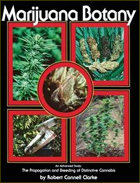
by Robert Connell Clarke
Late Floral Stage
By this stage plants are well past the main reproductive phase and their health has begun to decline. Many of the larger leaves have dropped off, and some of the small inner leaves begin to change color. Autumn colors (purple, orange, yellow, etc.) begin to appear in the older leaves and calyxes at this time; many of the pistils turn brown and begin to fall off. Only the last terminal pistils are still fertile and swollen calyxes predominate. Heavy layers of protective resin heads cover the calyxes and associated leaves. Production of additional capitate-stalked glandular trichomes is rare, although some existing trichomes may still be elongating and secreting resins. As the previously secreted resins mature, they change color. The polymerization of small terpene molecules (which make up most of the resin) produces long chains and a more viscous and darker-colored resin. The ripening and darkening of resins follows the peak of psychoactive cannabinoid synthesis and the transparent amber color of mature resin is usually indicative of high THC content. Many cultivators agree that transparent amber resins are a sign of high-quality Cannabis and many of the finest strains exhibit this characteristic. Particularly potent Cannabis from California, Hawaii, Thailand, Mexico, and Colombia is often encrusted with transparent amber colored instead of clear resin heads. This is also characteristic of Cannabis from other equatorial, subtropical and temperate zones where the growing season is long enough to accommodate long term resin production and maturation. Many areas of North America and Europe have too short a season to fully mature resins unless a greenhouse is used. Specially acclimatized strains are another possibility. They develop rapidly and begin maturing in time to ripen amber resins while the weather is still warm and dry.
The weight yield of floral clusters is usually highest at this point, but strains may begin to grow an excess of leaves in late-stage clusters to catch additional energy from the rapidly diminishing autumn sun. Total resin accumulation is highest at this stage, but the period of maximum resin production has passed. If climatic conditions are harsh, resins and cannabinoids will begin to decompose. As a result, resin yield may appear high even if many of the resin heads are missing or have begun to deteriorate and the overall psychoactivity of the resin has dropped. THC decomposes to CBN in the hot sun and will not remain intact or be replaced after the metabolic processes of the plant have ceased. Since cannabinoids are so sensitive to decomposition by sunlight, the higher psychoactivity of amber resins may be a secondary effect. It may be that the THC is better protected from the sun by amber or opaque resins than by clear resins. Some late maturing strains develop opaque, white resin heads as a result of terpene polymerization and THC decomposition. Opaque resin heads are usually a sign that the floral clusters are over-mature.
Late floral clusters exhibit the full potential of resin production, aromatic principles, and psychoactive effect. Complex mixtures of many mon oterpene and sesquiterpene hydrocarbons along with alcohols, ethers, esters, and ketones determine the aroma and flavor of mature Cannabis. The levels of the basic terpenes and their polymerized byproducts fluctuate as the resin ripens. The aromas of fresh floral clusters are usually preserved after drying, as by the late floral stage, a high proportion of ripe resins are present on the mature calyxes of the fresh plant. Cannabinoid production favors high THC acid and rising CBN acid content at this stage, since most active biosynthesis has ceased and more THC acid is being broken down into CBN acid than is being produced from CBD acid. CBD acid may accumulate because not enough energy is available to complete its conversion to THC acid. The THC-to-CBD ratio in the harvested floral clusters certainly begins to drop as biosynthesis slows, because THC acid levels decrease as it decomposes, and at the same time CBD acid levels remain or rise intact since CBD does not decompose as rapidly as THC acid. This tends to produce marijuana characterized by more somatic and sedative effects. Some cultivators prefer this to the more cerebral and clear psychoactivity of the peak floral stage.

